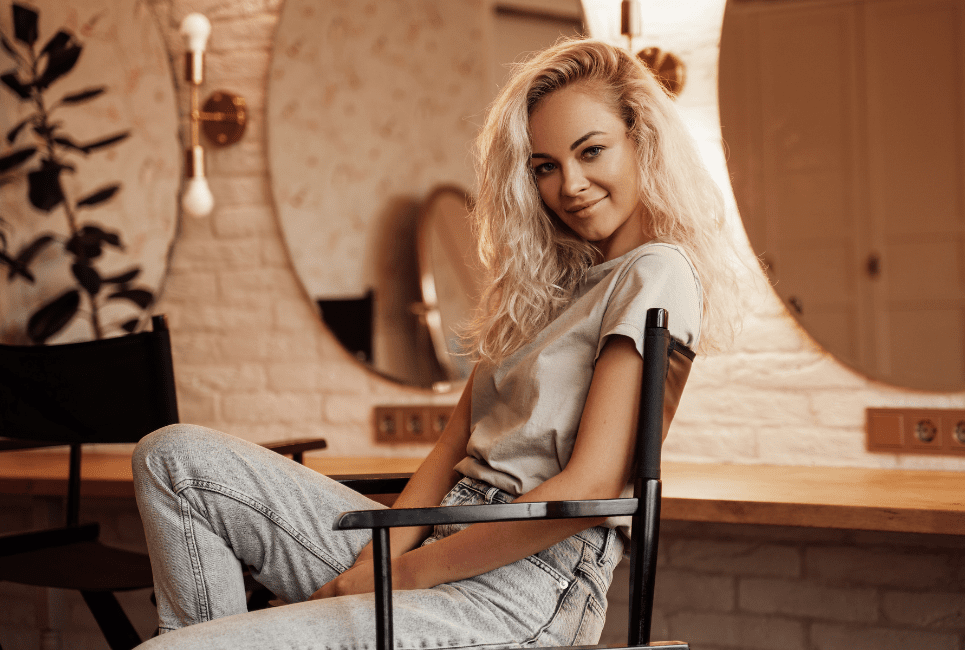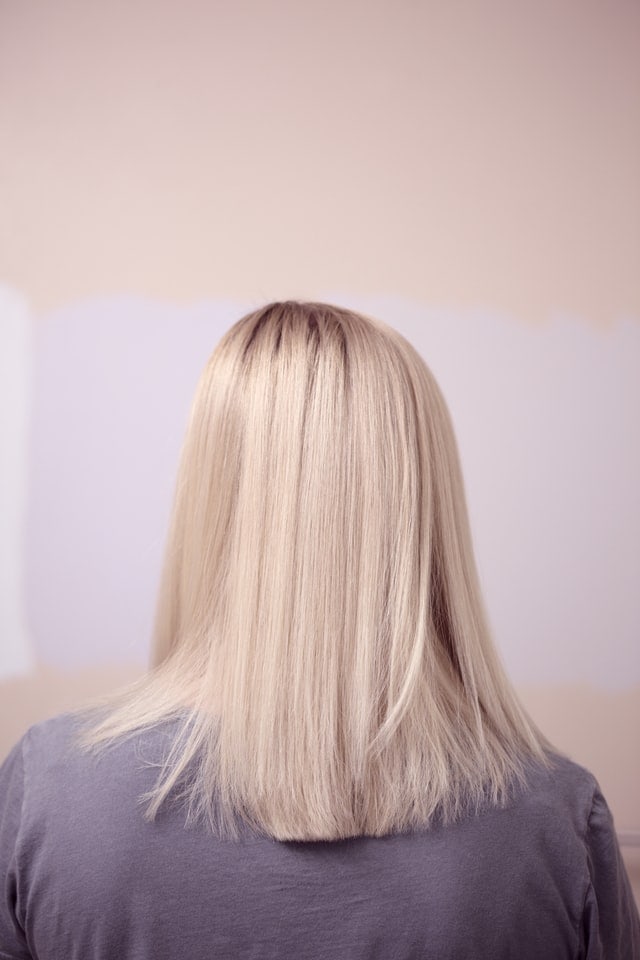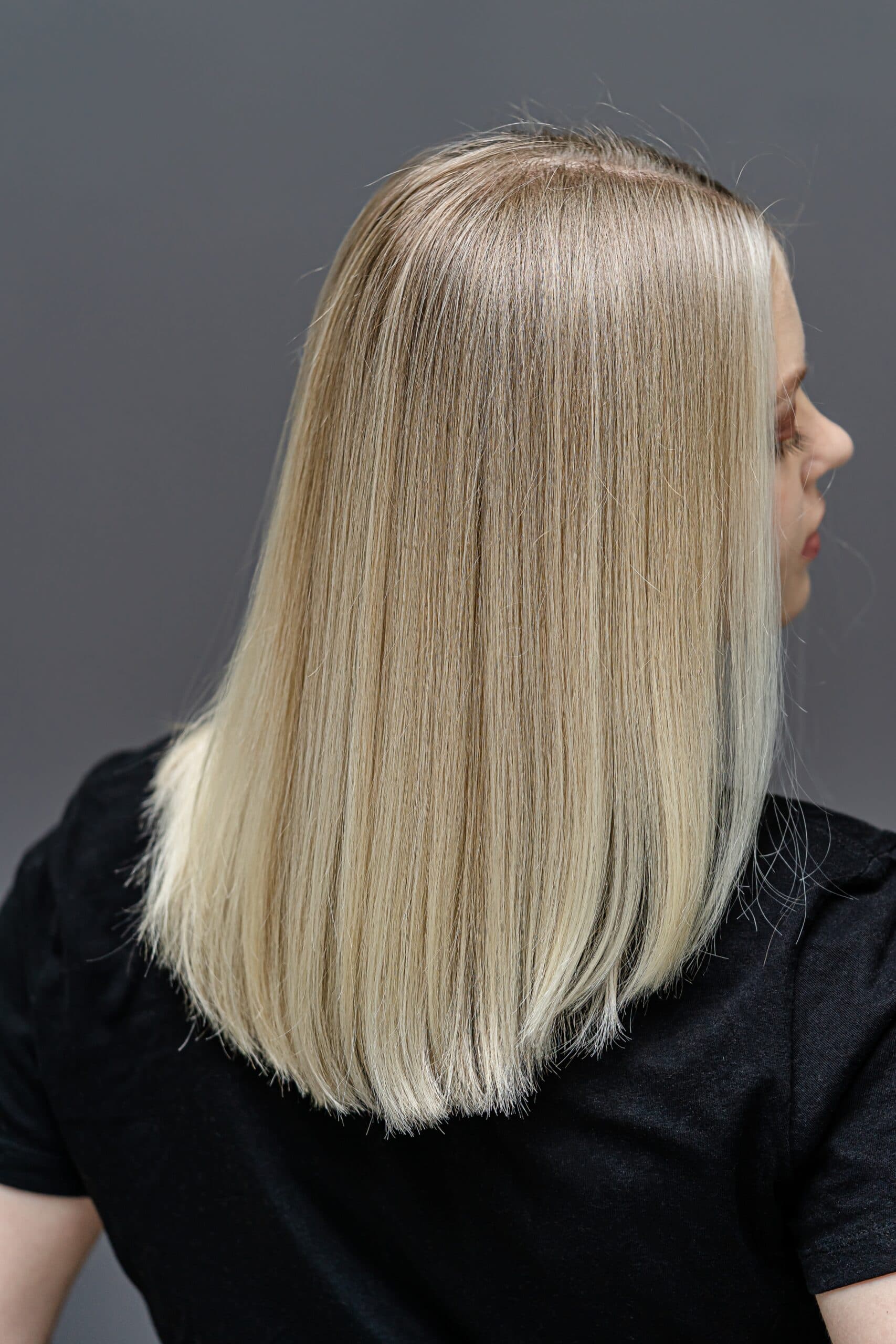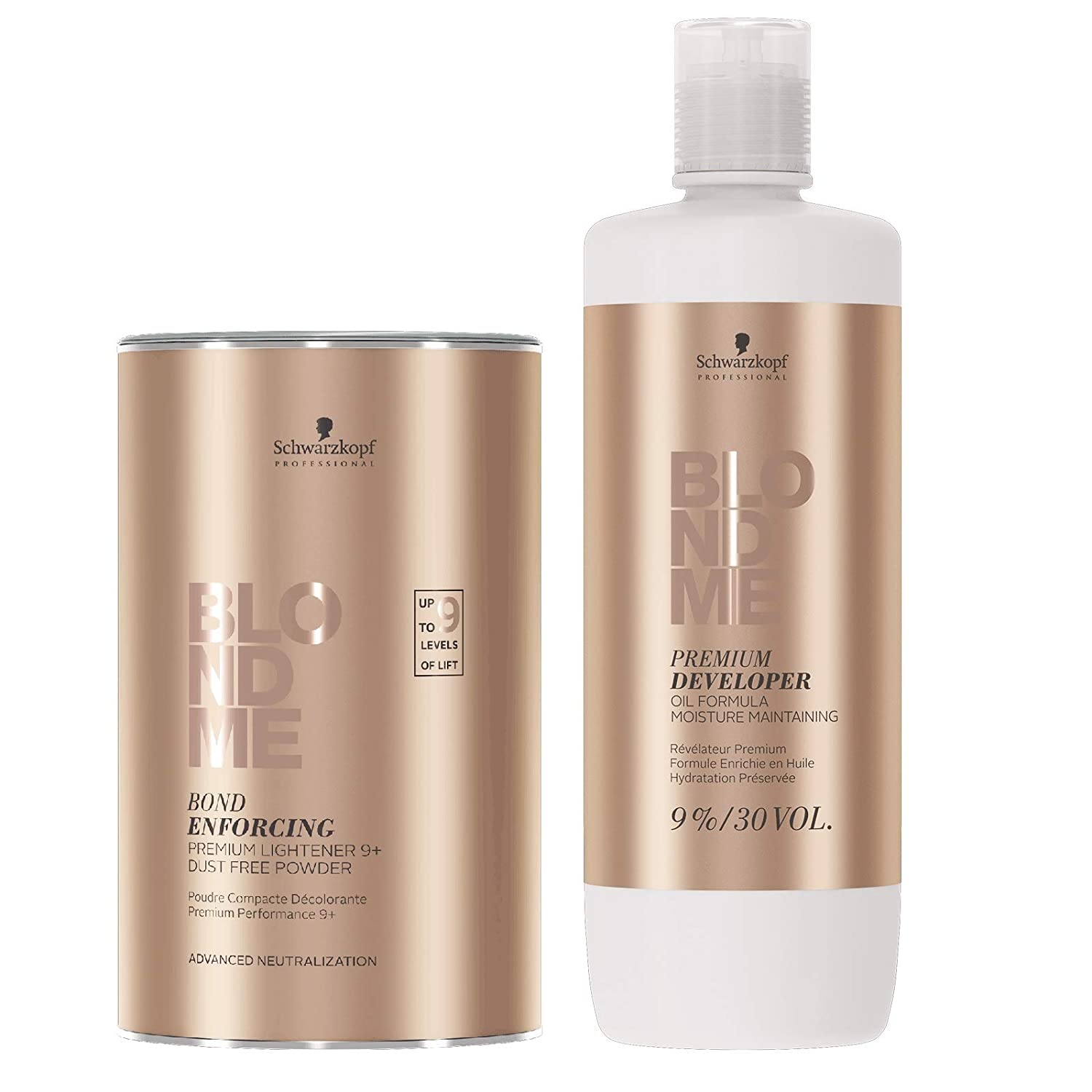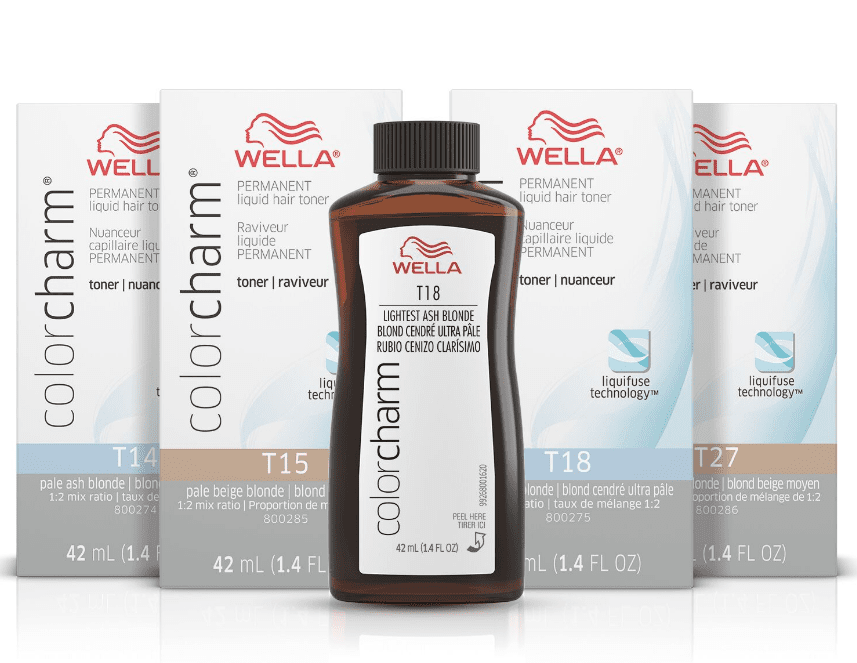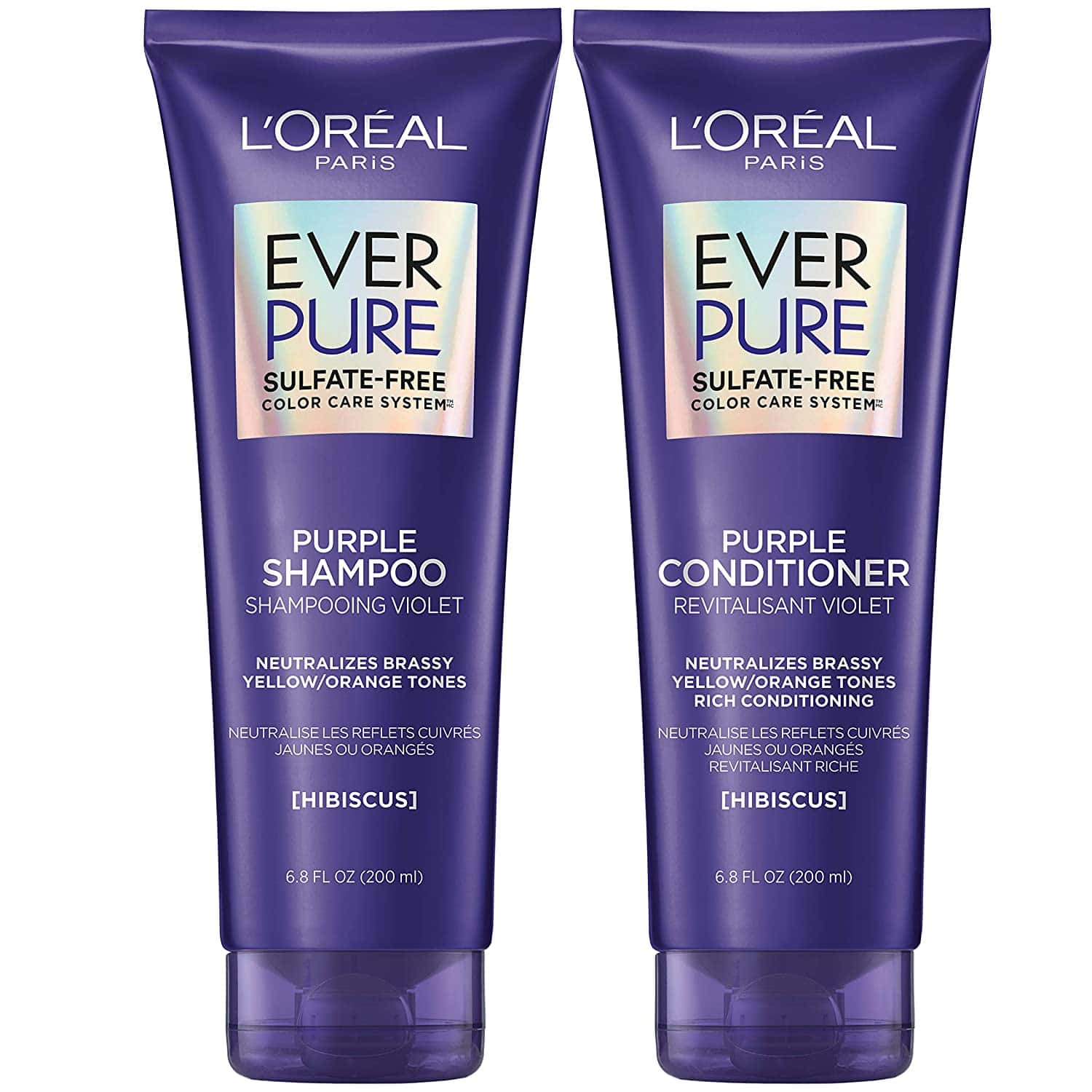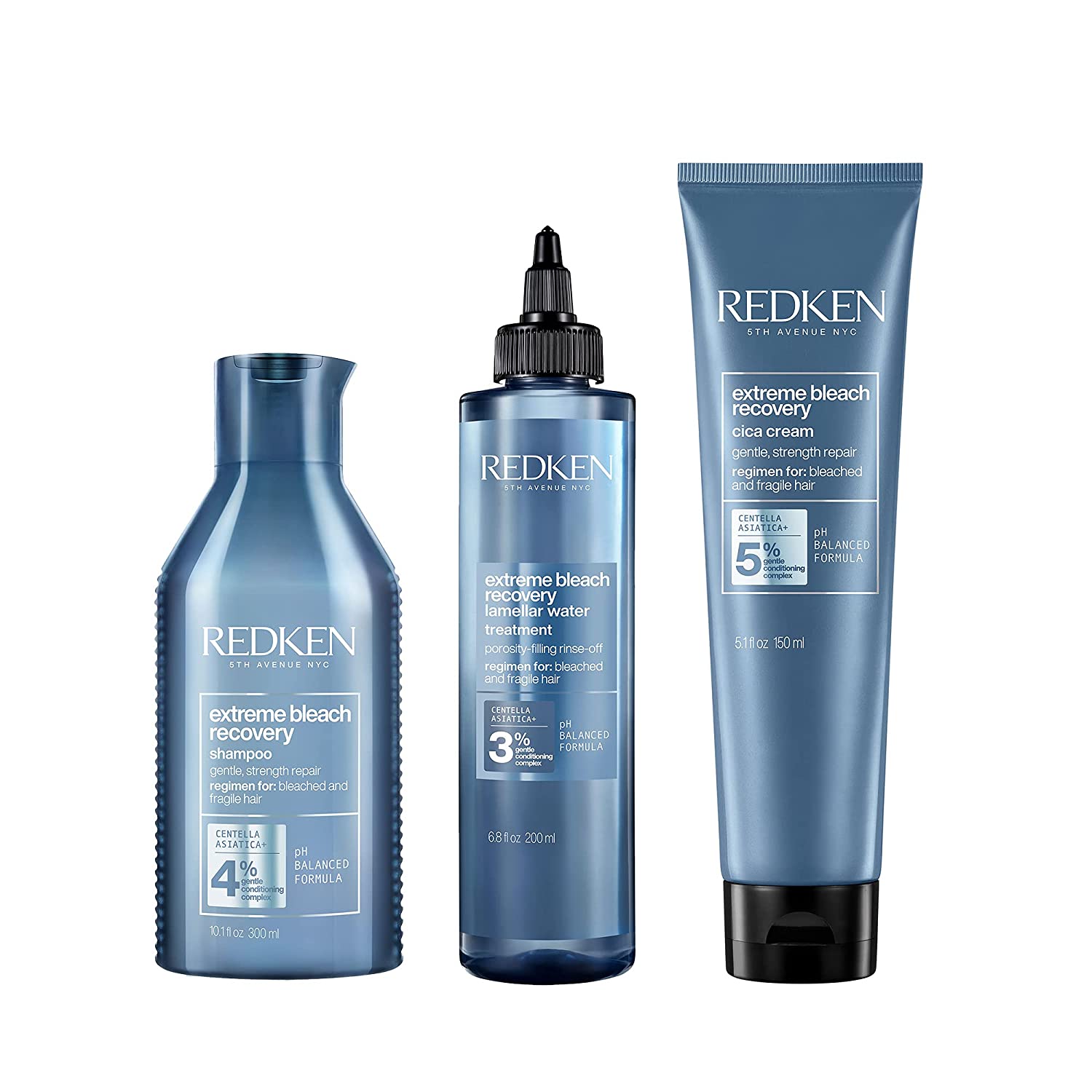I have been a hairstylist for ten years now and have seen some CRAZY things when it comes to people trying to bleach their hair. The craziest thing I’ve witnessed was a woman(we’ll call her Sam) who bleached her hair three times in one day and two more times throughout the week. Somehow, she still had enough decent hair on her head that I only had to chop it to her chin. This might make you wonder, “How many times can you bleach your hair?”
The answer is most definitely not five times in one week. Sam thought this was the correct route because she did not know you are supposed to tone out yellow instead of bleaching until it is gone. Luckily, Sam must have started with very healthy hair, and it was on the coarser side, so her hair did not melt off. Keep on reading if you would like to know why this helped her and what the correct amount would have been.
Bottom Line Up Front
In general, you should not bleach your hair more than two times a day, and you must wait a minimum of two weeks before attempting to bleach it again. However, many factors can make that number go up or down, including your hair history, hair type, bleach strength, and hair health. It would be best if you also kept in mind that, unfortunately, it is not always going to be possible to reach your goal.
Factors to Consider
There are many things to consider when deciding how many times you can bleach your hair. Everyone’s hair is different, which means everyone’s hair should be treated differently. Finding the answer to each of these factors below will help you figure out how often you can bleach your hair.
Your Hair History
Yes, what you have done to your hair in the past will affect how often you can bleach your hair and the outcome. When looking at your hair history, you should consider the things done to your hair in the past three years. I know that may seem like such a long time, but if your hair is long, you most likely still have whatever was going on in your hair three years ago throughout the ends.
- Previously Colored Hair: Hair that has artificial color molecules does not lift as easily and, therefore, will need a stronger bleach formula to lighten. You should also consider the ingredients in hair colors you have previously used. Some at-home hair dyes contain metallics, usually “natural” hair dyes, which you should never bleach unless you want your hair to be green or start smoking and melting.
- Previously Lightened Hair: If you have ever had highlights or had your hair drastically lightened, it was most likely done with bleach. This means that you need to consider your hair health, and your hair will most likely lift quicker. I recommend using a weaker bleach formula on previously lightened hair.
- Previously Chemically Treated Hair: By chemically treated hair, I mean hair that has altered the texture with chemicals, such as perms or relaxers. These tear down the bonds in your hair that hold it together and reform them to create a new texture, which causes damage to the bonds. Bleach will only further damage these bonds, so you should be extremely careful when lightening chemically treated hair.
- Natural Hair: This is what we hairstylists call “virgin hair” and it is the holy grail over hair types when it comes to bleaching. Hair that has never been touched with bleach, color, or chemicals is the easiest to lighten without hardly causing any damage. However, if you have colored your hair back to its natural color in the last three years, it does not fall under “natural hair,” It would be considered “colored hair.”
Your Hair Type
Many different things go into determining hair types, like texture, thickness, and density. The only thing that we will consider when looking at how many times you can bleach your hair is the thickness of your hair. People often confuse this with density, which is how much hair you have, but thickness defines how thick each individual strand is. For example, you can have thick hair density and fine hair thickness.
To determine your hair thickness, you’ll need to do a strand test by taking a single strand and rolling it in between your fingers. Below you can find the different hair thicknesses and how to determine which one you are:
- Fine Hair: This hair type has the smallest strand diameter and will hardly be felt when rolling it in your fingers. It is usually very limp and easily bends when moving it around. Fine hair lightens much faster than other hair types but can also become damaged quicker if not taken care of properly.
- Medium Hair: Medium hair can be felt in the fingers but feels smooth and has some movement. Most peoples’ hair is within the medium range but can also be defined as medium-fine or medium-coarse. This hair type can be lightened easily depending on other factors and is slightly more resistant to damage.
- Coarse Hair: When rolling coarse hair in your fingers, it feels thick and is likely a slightly rough feeling. This hair type is very rigid, meaning it does not bend easily and holds its natural shape better than other hair types. Coarse hair is slightly resistant to bleach but can also resist damage better.
How to Check Your Hair Health
The most basic way to check your hair’s health is by looking at it. For example, if it seems dull, frizzier than usual, and tangly, it is probably damaged to a degree. However, this is not the most accurate way to check your hair health because some hair types are naturally duller and frizzier than others. Here are a few tests you can do on your hair to check if it is healthy:
- Slide/Feel Test: Your hair’s outer layer is called the cuticle, and it is made of overlapping layers that open and close to allow things inside your hair, such as hair color. Start this test by grabbing one strand of hair and sliding your fingers up and down it. These layers should lay down flat if you have healthy hair, making your hair feel smooth as you slide your fingers along the strand. If you have damaged hair, the layers will be open, causing your hair to feel rough and bumpy as you slide your fingers.
- Elasticity Test: Hair naturally stretches up to 1.3 times its length when wet without breaking if it is healthy. To check your hair’s elasticity, first, you must wet your hair. Then take one strand of hair, holding it from each end with about a two-inch gap between your fingers. Slightly stretch the hair by pulling it in opposite directions. It is not healthy if the hair strand breaks easily or does not bounce back to its regular length.
- Dry Time Test: As mentioned above, the hair’s outermost layer is called the cuticle, and it is made up of layers. If you have healthy hair, these layers are tightly closed and will repel water, making it dry faster. Damaged hair will have open layers that allow all the water to enter the hair and make it dry much slower.
Different Strengths of Bleach
For bleach to lighten your hair, you must mix it with a developer. A developer is the part of hair color that opens the cuticle so that the color can go into your hair and work its magic. There are generally five different types of developers, and the higher you go in number, the stronger it makes the bleach. Below are the five types of developers and when you should use them.
- 5 Volume: This developer is rarely used because it is almost water. The only time that I recommend using a five-volume developer with bleach is if your hair is extremely fine and already lighter in color or if you are already blonde, but it got a slight tint to it from purple shampoo or hard water.
- 10 Volume: This is the least damaging developer that can still take your hair places. I like to use this developer if I am doing the second bleaching in a day or someone’s hair is already damaged. This is not me saying you should bleach severely damaged hair. Hair damage is more of a spectrum than a definite, so only use bleach with ten-volume on slightly damaged hair.
- 20 Volume: Twenty-volume developer is the most used developer with bleach, and it has lifting power without completely blasting open your cuticle. You can still use it over previously lightened or chemically treated hair as long as the hair is not damaged, you keep an eye on it, and do not let it sit longer than 45 minutes.
- 30 Volume: This developer hits the sweet spot for darker, virgin hair or healthy previously colored hair. It has quite a bit of lifting power but isn’t the most potent bleach formula. Do not use thirty-volume on previously lightened hair, chemically treated hair, or damaged hair.
- 40 Volume: Forty-volume is there whenever you need to whip out the big guns. This is another one that I hardly ever use because it is the strongest and the most damaging. I only use a forty-volume developer with bleach if someone’s hair is natural, near black, coarser, and they want to be blonde. NEVER use forty-volume on previously lightened, chemically treated, or damaged hair.
How Many Times Can You Bleach Your Hair?
Here is the moment you have all been waiting for, a more definite answer to the question, “How many times can you bleach your hair?” Now that you have more knowledge about the factors to consider during this process, here are the number of times your can bleach your hair for different situations:
Natural, Coarse, Healthy Hair
- In one day: You can bleach your hair twice in one day as long as you only use a ten-volume developer the second go-round. I would not bleach more than once a day if you are using a forty-volume developer for the first bleach application. Remember not to let your bleach process for longer than 45 minutes in each session, and make sure your hair is completely dry for the second session.
- Overtime: If you have done two bleaches in one day, as mentioned above, and are still not light enough, you can bleach your hair again after waiting for two weeks (preferably four weeks). I do not recommend bleaching more than once a day from here on out, but you can bleach your hair up to four more times, spreading them out over time. Make sure you check your hair’s health before bleaching each time and do not bleach your hair again if it is damaged.
You’re Somewhere in the Middle
- In one day: You can bleach your hair twice in one day with this hair type as well. The difference is the first bleach session should be with a twenty or ten-volume developer, and the second bleach application should be done with a ten-volume developer. Again, do not let it process longer than 45 minutes and check on it in between.
- Overtime: If you are still not your desired lightness, you can bleach your hair up to two or three more times with a four-week break in-between applications. I recommend only bleaching your hair once a day after the first bleach application, and make sure to check your hair health in-between applications. Do not bleach your hair again if it starts becoming damaged.
Previously Lightened, Fine, Damaged Hair
- In one day: Do not bleach your hair more than once a day if it is any one of these things. If it is all three, I would reconsider bleaching your hair. If you do decide to go forward with the bleaching process, I recommend only using a five or ten-volume developer with your bleach. However, your hair would have to be reasonably light already to make much difference.
- Overtime: I do not recommend bleaching your hair more than once if it is fine or damaged. If you have checked your hair health and feel it is relatively healthy, you can bleach your hair one more time with a minimum of a four-week waiting period. Again, you should only use a five or ten-volume developer for this bleaching process and keep a close eye on it while you’re waiting.
When to Put the Bleach Down
Sadly, not all of us can reach our blonde goals all the time. There are certain instances where not even bleaching your hair until it falls onto the ground will make it blonde. I’ve listed a few scenarios below where you may want to reconsider your hair color choices and move on to a new color.
- It doesn’t seem to be lightening anymore: There are times when your hair decides it does not want to be any blonder, and layering on bleach won’t make it budge any further. Many things can cause this, including the things you eat, specific health problems, and the things inside or on your hair. You’ll know when to stop when you’ve left the bleach on your head for 45 minutes, and it has hardly gone anywhere.
- Your hair is becoming significantly damaged: Before each bleaching session, you should check your hair’s health by using the tips listed above. If your hair shows any signs of significant damage, you should not bleach it again. This can lead to your hair literally falling off or being cut down to a pixie cut so that it can grow back healthy.
- Your goal is unrealistic: Unfortunately, bleach is not magical pixie dust that can turn you into Barbie overnight. I love the optimism, though! Certain things are unrealistic when it comes to hair color, such as going from colored black hair to platinum or dying your hair red for years and wanting it a cool blonde, and those things don’t happen without some significant damage being done.
Bleaching After Care
No matter how slow you take it, bleaching your hair will always cause some level of damage. Nevertheless, there are ways to keep it from becoming overly damaged and make it feel soft and healthy. Here are a few things you can do to care for your hair between and after bleaching treatments.
Tone Your Hair
There is absolutely no way to get a cool or natural-looking blonde with only bleach. If you try to achieve this by bleaching it repeatedly, your hair will become damaged. You must tone your hair to get cool or natural blondes. Toners are a demi-permanent color (deposit-only) that coats the outside of your hair with a shiny tint. They also do not damage your hair any further since they sit on your cuticle rather than opening it and going inside the cuticle.
One thing you should know about toners is they will not make your hair look lighter. They only change the tone of your hair, and you must choose a toner that is the same darkness that your hair has lifted to, or else it will not do anything. For example, if your hair is lifted to orange, you should choose an ashy toner that is a dark or medium blonde to cover the orange.
Use Protein Products
Bleach damages hair because it eats up protein and the melanin (what creates color) in your hair. Using products that restore that protein can make all the difference in keeping your hair healthy after bleaching. I recommend using a protein shampoo and conditioner and a protein mask once a week.
Another thing that you can try to keep your hair from getting damaged during or after bleaching is using a bind builder. These handy products go into your hair with the bleach to rebuild protein bonds while the bleach does its thing. One of the most common ones that you probably all have heard of is Olaplex, but many other brands are out there.
Use Purple Shampoo
Purple shampoo keeps your blonde hair from becoming brassy. A shampoo with purple pigment works because purple neutralizes yellow, meaning when purple and yellow are mixed, they create a neutral color. I wouldn’t use this every time you shampoo because it can eventually overdo its job and tint your hair purple. Switching between protein and purple shampoo every two washes is a good idea.
Products I Recommend
Schwarzkopf BlondMe
Pros
- Great lifting power
- Has anti-yellowing agents
- Professional bleach
- It has bond protection
Cons
- Pricey
Schwarzkopf Blondme is a bleach that you will find hairstylists using in salons, and it works great. It has a possibility of lifting your nine levels, meaning you can go from a dark brown to light blonde in one day as long as your hair is healthy enough to do so. The bleach itself is also a blue color, which helps your hair from turning as yellow in the end and makes it easier to tone.
Because Schwarzkopf is a professional brand, it is a bit pricier than other bleaches, especially if you get the bleach and developer duo. However, it is worth it because it is much less harsh than cheaper bleaches with added bond protection inside the bleach. The bleach actively keeps protein bonds in your hair from breaking while it lifts. Haircare is one of those things that price really does reflect quality.
Wella Color Charm Permanent Liquid Toner
Pros
- Professionals use it
- It goes beyond regular toners
- Works on darker blondes and lighter blondes
- Can be found at Sally’s Beauty
Cons
- Permanent color
Wella is a brand that you can find in almost any drug store and Sally’s Beauty Supply. Usually, this means that it is not a high-quality product, but Wella has come a long way. So much so that you may see professional hairstylists using Color Charm toners in the salon. One toner that hairstylists rave about is Wella T-18 because it is strong in toning out the brassiness.
The downside of Wella’s Color Charm toners is that they are permanent colors, and this is why they do such a great job at lifting out brassiness, but it can also damage your hair further since it is reopening the cuticle. It may also lift your natural hair color if you leave it on too long when you only want to tone highlights. You absolutely can not use anything higher than a ten-volume developer with this toner.
L’Oreal Paris EverPure Purple Shampoo
Pros
- Comes with conditioner
- Sulfate and paraben-free
- Immediate results
- More moisturizing than other purple shampoos
Cons
- Not a great scent
Purple shampoos are one of those things in the hair industry that vary drastically in effectiveness from brand to brand. EverPure is an excellent in-between purple shampoo that does a great job toning out brassiness without going overboard and turning your hair purple. Purple shampoos are also notorious for being drying, and this one is not because it includes a conditioner and is sulfate-free.
The only thing I do not like about EverPure is its smell because it is almost masculine, like a men’s stick of deodorant. It states that it is hibiscus scented, but that is not what I get from it. I get more of a tea tree smell, which some people prefer, but it is not a feminine smell.
Redken Extreme Bleach Recovery Bundle
Pros
- Tailored to bleached hair
- It contains shampoo, treatment, and leave-in
- Restores hair porosity
- Reduces breakage
Cons
- Pricey
I recently purchased this for one of my friends that has been bleaching her hair for years, and it did wonders for her. I had not seen her hair as smooth or shiny as it was after just one use in years, and I hope it will help her hair breakage. It should because it goes into the cuticle to fill in the open flaps that cause your hair to become damaged or porous.
This bundle is quite an investment, but isn’t your hair health worth it? My friend that I got this for was lucky enough to get the professional cosmetologist discount, but it was still quite a bit even then. However, I think this stuff is worth the price because I can tell it works.
FAQ’s
Answer: Even though it would work to an extent, you definitely should not try to bleach your hair with household bleach. Regular household cleaning bleach is much more dangerous if it touches your skin or gets in your eyes than hair bleach because it can actually poison you with repeated use. Cleaning bleach also does not have the component that opens your cuticle (developer) for the bleach to enter your hair cuticle, so it doesn’t work as well.
Answer: The simple answer is no. Technically, any chemical you use is going to damage your hair. Anything that changes the color or texture opens the outer layer, the cuticle, that keeps your hair healthy. The more you open and close your cuticle with hair color or any other chemical, the less it’s willing to close again. An open cuticle is what causes damaged hair. When your hair is damaged to a certain point, the only thing to do is chop it. Once the damaged hair is gone, new healthy hair will take its place.
Answer: Not if you do it correctly. There are many factors to consider when choosing the strength of bleach to use and how to apply it to keep your hair healthy, including your hair type, hair history, and current hair health. If done correctly, considering all of these, bleach is no more damaging than regular hair dye.
Answer: The best option is to use a high lift color. This type of permanent color has more lifting power than standard permanent color. However, nothing out there will lighten your hair as much as bleach can. Also, please do not put lemon juice on your head and stand in the sun because it is way more damaging than bleach, even though it is technically natural.
Answer: The simple answer is it is impossible. Every dark-haired person who bleaches their hair turns orange because warm colors are the underlying pigment in hair that doesn’t leave when bleached. The only way to bleach dark hair without turning it orange is by either toning it to a dark blonde or lightening it past the orange stage and toning it to blonde.
Final Thoughts
Everybody’s hair is different and, therefore, should be treated differently. There is never a simple answer to how many times you can bleach your hair, and I hope that this guide makes it easier for you to determine your hair type, history, and health to make an informed decision on bleaching your hair. Even though the process can be stressful, remember that blondes do have more fun.
Looking for more interesting readings? Check out:
- Straight Hair Balayage Ideas Guide That You’ll Love!
- Reverse Balayage Ideas And Style Guide
- Balayage Vs Highlights: What’s The Difference?

